Thurlby railway station
Disused railway stations in LincolnshireFormer Great Northern Railway stationsPages with no open date in Infobox stationRailway stations in Great Britain closed in 1951Railway stations in Great Britain opened in 1860 ... and 1 more
Use British English from August 2015

Thurlby railway station was a station in Thurlby by Bourne, Lincolnshire on the Bourn and Essendine Railway between Essendine and Bourne. It was closed in 1951.
Excerpt from the Wikipedia article Thurlby railway station (License: CC BY-SA 3.0, Authors, Images).Thurlby railway station
Station Road, South Kesteven Thurlby
Geographical coordinates (GPS) Address Nearby Places Show on map
Geographical coordinates (GPS)
| Latitude | Longitude |
|---|---|
| N 52.7367 ° | E -0.3836 ° |
Address
Station Road
Station Road
PE10 0JA South Kesteven, Thurlby
England, United Kingdom
Open on Google Maps








